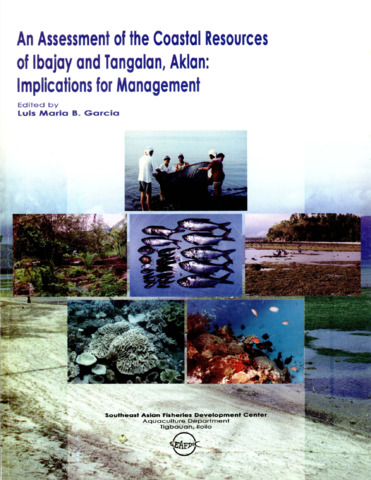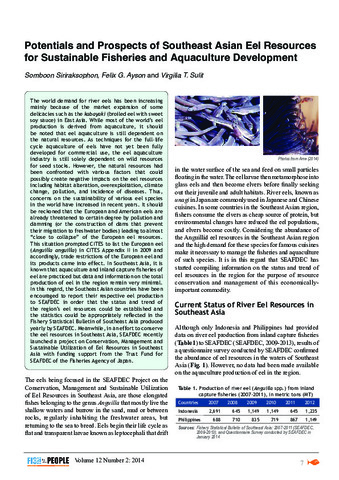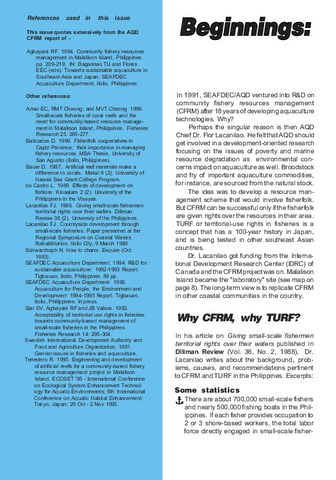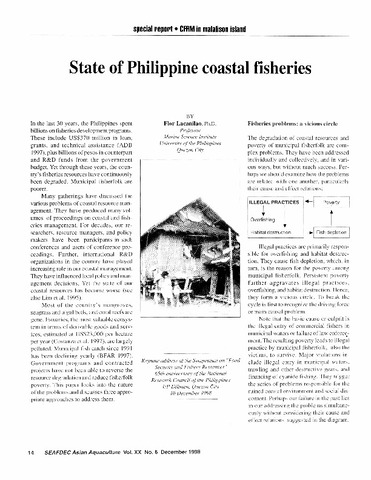An assessment of the coastal resources of Ibajay and Tangalan, Aklan: Implications for management
| dc.contributor.editor | Garcia, Luis Maria B. | |
| dc.date.accessioned | 2015-07-09T03:20:23Z | |
| dc.date.available | 2015-07-09T03:20:23Z | |
| dc.date.issued | 2001 | |
| dc.identifier.citation | Garcia, L. M. B. (Ed.) (2001). An assessment of the coastal resources of Ibajay and Tangalan, Aklan: Implications for management. Aquaculture Department, Southeast Asian Fisheries Development Center. | en |
| dc.identifier.isbn | 9718511547 | |
| dc.identifier.uri | http://hdl.handle.net/10862/2272 | |
| dc.description.abstract | This report describes the present state of marine resources in several coastal barangays of Ibajay and Tangalan, Aklan (Philippines). Field data were obtained from rapid surveys conducted from July to September 1998. Recommendations based on analyses of the data will guide fisherfolk and other stakeholders, particularly the local government units, in their development plans for these neighboring municipalities. Both land and marine products in the area are mainly harvested for the local market. All coastal barangays are dependent on fishing for their livelihood. The medium-scale municipal fishery of Tangalan employs several passive (encircling gill net, bag net, fish corral) and active gears (baby purse seine) compared with the traditional fishing methods employed by Ibajay fishers. Pond aquaculture in mangrove areas is well-developed in Ibajay West (barangays Aquino and Ondoy) and in Tangalan. However, ownership of these ponds is limited to a few individuals and families, unlike in Barangay Bugtong Bato where informal ownership distributed among families has been the traditional rule. Nonetheless, the introduction of so-called environment-friendly methods of utilizing mangroves (e.g., aquasilviculture) and other shared coastal resources may seriously undermine the informal rights-based social structures in the barangays. Without proper rules and enforcement, the application of these methods may be misused, aggravating the already poor overall state of their coastal resources. Major problems affecting their fishing livelihood include siltation of nearshore waters due to illegal deforestation upland, encroachment of municipal fishing grounds by commercial and other fishers elsewhere, and the lack of capital to finance the fishery. Weak inter-organizational links among government and non-government organizations have hampered the implementation of solutions to these common problems in coastal barangays. For instance, a conflict between fishers from these neighboring municipalities over territorial boundaries of common fishing grounds in Pangayawan and Pungtod reefs has not been resolved over the years. Likewise, the introduction of aquasilviculture in mangrove areas may become a potent source of conflict among resource-users who maintain informal rights over the mangrove resource. The overall state of coastal resources in these municipalities is in immediate need of a unified plan to promote both their preservation and conservation. To achieve this end, a joint resource management council representing all resource-users from both municipalities must be organized and convened. To address the presently weak inter-organizational links among existing organizations, this joint council may provide a legitimate forum to identify, resolve, integrate, implement, and enforce guidelines on the common use of resources, both marine and inland. Low estimated yields from the reef fishery, conversion of mangroves for aquaculture beyond the allowable limit, a persistent conflict over fishing rights in several reefs offshore, the limited resources for seaweed and fish mariculture, and threats on existing traditional social structures by progressive resource-users are several issues that require thorough discussions to formulate popularly approved and acceptable management strategies. These strategies include community-based approaches of co-managing resources such as "no-take zones" (sanctuaries), ecotourism development, and livelihood schemes to mitigate, in part, the pressure of over-exploitation of fishery resources. | en |
| dc.format.extent | 60 p. : ill. | |
| dc.language.iso | en | en |
| dc.publisher | Aquaculture Department, Southeast Asian Fisheries Development Center | en |
| dc.subject | Philippines | en |
| dc.title | An assessment of the coastal resources of Ibajay and Tangalan, Aklan: Implications for management | en |
| dc.type | Book | en |
| dc.subject.asfa | marine fisheries | en |
| dc.subject.asfa | sociology | en |
| dc.subject.asfa | management | en |
| dc.subject.asfa | living resources | en |
| dc.subject.asfa | fishery management | en |
| dc.subject.asfa | artisanal fishing | en |
| dc.subject.asfa | coastal fisheries | en |
| dc.subject.asfa | aquaculture | en |
| dc.subject.asfa | fish culture | en |
| dc.subject.asfa | fishery resources | en |
Files in this item
รายการนี้ปรากฏใน (s)
-
Institutional Reports [2]
-
Monographs [33]





